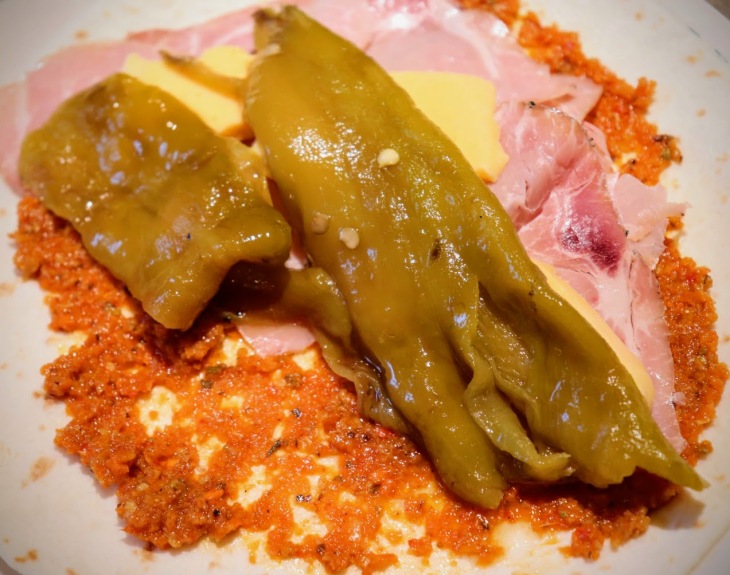
In southeastern Pennsylvania just about everyone knows where to find a good hoagie. Growing up there, you could get a $2 sandwich that might feed you for two days. Even when the price doubled, it was a lot of food, and very tasty with with Italian-style cold cuts, cheese, lettuce, tomato, onion, and hot peppers. We knew which Italian bakeries made the right bread for the best sandwich; you have to get the proper roll for each sandwich: hoagie, cheese steak, meatball sandwich.
I like a layering of hot peppers. A jarred condiment called hoagie spread is chopped pickled or oil packed hot peppers. It is spread on the roll, then topped with the meats, cheese, and vegetables. More hot peppers on top. Hoagie spread is great stuff, and very easy to make. I just dip some of the fermented mash out of the crock when I make my fermented hot sauce. It is shelf stable, and keeps in the fridge. I put it on lots of things.

A similar, but much more complex sandwich spread, Miscela Esplosiva, can be found in Italian markets. As the name implies, it is a hot mixture of miscellaneous ingredients. Sort of like a very spicy, finely minced hot giardiniera. It’s chock full of goodness, and when spread on the bread for a sandwich, it elevates that sandwich right to the top shelf where they keep the good stuff. You want this, and I am going to tell you how to make your own.
I happened to have everything on hand already to make this, much of it fresh from the garden. This makes about 2 quarts.
Miscela Esplosiva
320g Red Peppers (Pimiento de Arnoia, a Spanish variety)
301.5g Carrots, peeled
375g Eggplant, peeled and cubed
73g Garlic, peeled
308g Artichoke Hearts (frozen, thawed)
245g Mushrooms (wild foraged grifola Frondosa)
52g Trapani sea salt (works out to about 3% of the weight of the other ingredients)
65g Calabrian red pepper powder
35g Tomato powder (dried and ground skins from canning tomatoes, sub sun-dried tomatoes if needed)
15g Oregano, dried
5g Black Pepper
25g Paprika (Ubatuba peppers)
150g Olive Oil
350g Apple Cider Vinegar
Prep the first six ingredients, weighing them so you can then measure the right amount of salt. Sprinkle some of the weighed out salt on the cubed eggplant to keep it from browning. Mince everything very finely using a knife or a food processor (I used the latter).
You may want to change the ratio of items in the mix, or add other items. That is fine, but keep the salt level at 3%.
Place the minced items into a large bowl and add in the remainder of the salt, the Calabrian pepper powder, tomato powder, oregano, black pepper, and paprika. Mix thoroughly. Let rest for 30 minutes.
After 30 minutes, the salt should have drawn out enough water to form a brine. If not, then add some water 100ml at a time and 3g salt for each 100ml water to maintain 3% salt by weight. The mix needs to be spreadable, not soupy.
Pack the mixture into a 2 quart seal-able jar. I used a 2-quart Mason jar. The jar needs to be filled very close to the top so there is very little head space. There should be liquid on top of the mixture in the jar. If not, place a small piece of plastic wrap on top of the mixture and press down so the solids are beneath a layer of liquid. Air is your enemy in the next step; air will allow mold to grow and my spoil your efforts. Seal the jar with a lid. I use a plastic Ball lid that is used for storing food in canning jars (not for processing in hot water bath or pressure canner). The lid can be firmly attached.
Leave the jar at room temperature on the kitchen counter for about two weeks. During this time, the salt brine will allow the mixture to ferment and will deepen the complexity of flavor. Never open the jar, but you can and should check on it daily to make sure there is no pressure build up. Just very slightly loosed the lid and see if it releases any gas. This is normal, although these lids usually release pressure on their own.
After two weeks, open the jar and empty into a large bowl. Mix in the oil and vinegar. Now is a good time to taste and adjust the flavor if you feel the need. Package the mixture in jars, and put it to use.

I tested some out right away on a flour tortilla with cold smoked pork loin, aged Brick cheese, and roasted garden chilies.

Hi Tim it’s Lloyd. I am definitely going to make this !!!! I make a fermented version of Giardiniera. I love your your ingredient choices !
LikeLiked by 1 person
Thanks! I am thinking of doing another version of this for muffaletta. With olives, celery, and maybe some anchovies.
LikeLike
Hey Tim – it’s Rachel. This looks incredible! I’ll be sure to make this as well.
LikeLike
Thanks! Great to see you here!
LikeLike
You are making me hungry
Great read 🍺🍻cheers
LikeLiked by 1 person
I’m always hungry! Cheers!
LikeLike